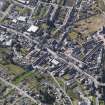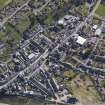Pricing Change
New pricing for orders of material from this site will come into place shortly. Charges for supply of digital images, digitisation on demand, prints and licensing will be altered.
Langholm, Townhead Bridge
Road Bridge (18th Century)
Site Name Langholm, Townhead Bridge
Classification Road Bridge (18th Century)
Alternative Name(s) River Esk; Telford Road; New Langholm; Langholm Bridge
Canmore ID 67703
Site Number NY38SE 54
NGR NY 36304 84687
Datum OSGB36 - NGR
Permalink http://canmore.org.uk/site/67703
- Council Dumfries And Galloway
- Parish Langholm
- Former Region Dumfries And Galloway
- Former District Annandale And Eskdale
- Former County Dumfries-shire
NY38SE 54 36304 84687
Townhead Bridge [NAT]
OS (GIS) AIB, March 2006.
(Location cited as NY 363 847). Built 1780, widened 1880. A 3-span bridge with flat segmental arches. Footpaths with lattice-girder parapets were added in 1880.
J R Hume 1976.
The sloping Townhead Bridge over the Esk was built by Robin Hotson in 1775, and has three segmental arches and triangular cutwaters. Its stone parapets were removed in 1880, when John Hyslop added cantilevered steel footpaths with lattice-girder parapets.
J Gifford 1996.
Townhead Bridge, from 1775, Robin Houston, widened, with iron-railked footpaths, 1880, and again, sympathetically, 1993-4 by Dumfries and Galloway Council.
J R Hume 2000.
This bridge carries Telford Road (which here forms the B709 public road) over the River Esk at the N end of Langholm High Street and just below (to the S of) the entry of the Ewes Water. It thus gives access to New Langholm and Upper Eskdale.
The location assigned to this record defines the midpoint of the structure. The available map evidence indicates that it extends from NY c. 36274 94697 to NY c. 36337 84673.
Information from RCAHMS (RJCM), 21 March 2006.
Publication Account (2007)
Langholm Bridge, now carrying the A79 road over the Esk, was built in ca.1775–78, probably jointly by local stonemasons Andrew Thomson and Robert Hotson. Its chief claim to fame is that Telford worked on the bridge as an apprentice mason to Thomson. Many people have searched its stonework for his mason mark. The mark on the east abutment recorded in 1996, which may or may not be Telford’s, differs from the earliest known publication of his mark by Smiles in 1861 who does not give his source. Telford also carved the headstone
of his father’s grave in Westerkirk churchyard. The bridge, typical for its date, has three segmental masonry arches, each of 41 ft span. The road is on an incline over the bridge and the rise–span ratios of the arches vary slightly to suit this. The masonry is uncoursed grey rubble with ashlar dressings, recessed arch rings and
pointed cutwaters. In 1880 the bridge was widened to 24 ft by John Hyslop with the addition of footways on each side carried on Duchess Bridge cantilevered iron brackets. In 1995–96 widening and strengthening work complementing the original design attracted a Saltire Civil Engineering Awards design commendation.
R Paxton and J Shipway 2007
Reproduced from 'Civil Engineering heritage: Scotland - Lowlands and Borders' with kind permission from Thomas Telford Publishers.






















































